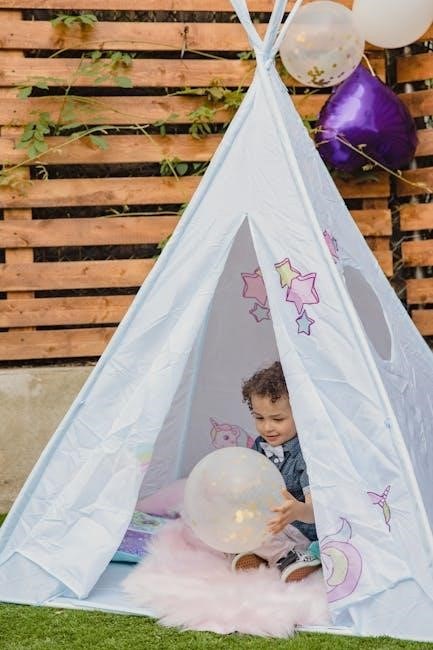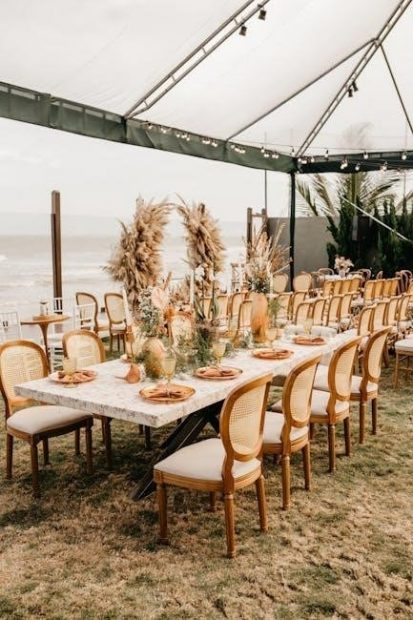A 10×30 party tent is a versatile and spacious shelter ideal for outdoor events, featuring a sturdy frame and waterproof canopy. This guide provides a detailed walkthrough to ensure safe and efficient assembly, covering all essential steps and safety precautions.
1.1 Overview of the Tent and Its Components
The 10×30 party tent consists of a durable steel frame, waterproof polyester canopy, and adjustable side walls. Its design includes a rectangular frame with hip rafters, crown fittings, and spreaders for stability. The tent also features clips or straps for securing the canopy and optional window panels for ventilation. The package typically includes poles, fittings, stakes, ropes, and detailed instructions. This structure is ideal for large events, providing ample space and weather protection, with components designed for easy assembly and disassembly.
1.2 Importance of Proper Assembly

Proper assembly of the 10×30 party tent is crucial for ensuring structural integrity, safety, and optimal performance. Incorrect assembly can lead to instability, damage from wind or rain, and potential safety hazards. Following the instructions carefully ensures the tent stands securely, providing reliable shelter and protection for your event. Proper assembly also extends the lifespan of the tent by preventing unnecessary stress on the frame and fabric, making it a vital step before any event.

Pre-Assembly Preparation
Before assembling, ensure a flat, obstruction-free area, unpack all parts, and organize tools. Proper planning and organization are key to a smooth setup process;
2;1 Choosing a Suitable Location
Selecting the right location is crucial for safe and successful tent assembly. Opt for a flat, level surface free from trees, power lines, or other obstructions. Ensure proper drainage to avoid water pooling. The area should be large enough to accommodate the tent’s footprint and provide space for stakes and ropes. Avoid soft or uneven ground, as it may compromise stability. Check for underground utilities and ensure the site is clear of debris before beginning assembly.
2.2 Unpacking and Inventory of Parts
Carefully unpack all components from the box to avoid damage. Verify the presence of poles, connectors, stakes, ropes, and the canopy. Check for any missing or damaged items by referencing the provided parts list. Organize the parts into categories, such as frame pieces, hardware, and fabric components, to streamline the assembly process. Ensure all items are accounted for before proceeding to avoid delays during setup.
2.3 Tools and Equipment Needed
To assemble the 10×30 party tent, gather essential tools: a screwdriver, wrench, hammer, measuring tape, and utility knife. Ensure you have sturdy ropes, stakes, and a mallet for securing the tent. Safety gear like gloves and safety glasses is recommended. Organize all tools and equipment beforehand to streamline the assembly process. Having a helper can also make the task easier and safer, especially when handling larger components like the canopy and frame sections.
Frame Assembly
Frame assembly involves attaching hip rafters to crown fittings, securing top spreaders, and ensuring all rafters are properly aligned for stability and structural integrity.
3.1 Assembling the Rectangular Frame
Begin by laying out the frame parts on a flat surface. Start with the legs and side poles, ensuring they are aligned properly. Attach the legs to the corners using connectors, then secure the side poles between them. Next, connect the top spreaders to the legs, ensuring they are evenly spaced. Use the measuring tape to verify the frame’s rectangular shape and alignment. Tighten all bolts and screws firmly to create a sturdy base for the tent. This step is crucial for stability and proper structure.
3.2 Attaching Hip Rafters to Crown Fittings
Locate the hip rafters and crown fittings. Insert the ends of the hip rafters into the 3-way crown fittings, ensuring they align properly. Secure them using the provided bolts or clips. Repeat this process for all hip rafters, working evenly around the frame. Make sure the connections are tight and the structure remains balanced. Properly attached hip rafters are essential for maintaining the tent’s shape and stability during assembly. Double-check each connection for security before proceeding.
3.3 Adding Top Spreaders and Rafters
After attaching the hip rafters, position the top spreaders across the frame to add width and stability. Secure them to the crown fittings using the provided hooks or bolts. Next, attach the rafters to the frame, ensuring they connect evenly between the top spreaders and the sides. Tighten all bolts firmly to maintain structural integrity. Double-check that the rafters are evenly spaced and the frame remains square. This step ensures the tent’s roof is properly supported and ready for the canopy attachment.

Canopy Attachment
Secure the canopy to the frame using clips or straps, ensuring a snug fit. Start from the center, working outward to avoid wrinkles. Tighten evenly for stability.

4.1 Securing the Canopy to the Frame
Begin by attaching the canopy to the frame’s center, ensuring alignment. Use clips or straps to fasten it securely, working outward to prevent wrinkles. Tighten evenly to maintain tension and ensure a smooth appearance. This step is crucial for maintaining structural integrity and weather resistance. Proper attachment ensures the canopy remains taut, preventing sagging and enhancing the tent’s durability. Follow the manufacturer’s instructions for clip placement and tightening sequences.
4.2 Tightening the Canopy Fabric

After securing the canopy, tighten the fabric evenly by adjusting the ropes or straps attached to the frame. Ensure there are no wrinkles or sagging areas. Use the provided tensioning straps to pull the fabric taut, starting from the center and working outward. Check each side for uniform tightness to prevent uneven stress on the frame. Proper tension ensures the canopy remains secure and maintains its shape, especially in windy conditions. Repeat the process until the fabric is drum-tight and stable.
4.3 Attaching Side and End Walls
Attach side and end walls to the tent frame using the provided Velcro strips or straps. Start by aligning the wall panels with the frame’s edges, ensuring a snug fit. Secure the walls tightly to the canopy and frame connections. Check alignment and tighten any loose straps to prevent gaps. Repeat for all walls, ensuring a weather-tight seal. Use additional straps or stakes if needed for extra stability and to secure the walls firmly in place.

Securing the Tent
Drive stakes into the ground at each corner and along the sides, ensuring the tent is firmly anchored. Tighten ropes and straps evenly for maximum stability and security.
5.1 Anchoring the Tent with Stakes
To securely anchor the tent, insert stakes into the ground at each corner and along the sides, ensuring they are driven in fully. Use rope tighteners to tighten the ropes around the stakes, creating a firm grip. For added stability, place weights or additional stakes at the midpoints of the tent’s sides. This ensures the structure remains stable, even in windy conditions. Always check that the tent is evenly tensioned to prevent shifting or damage.
5.2 Tightening Ropes and Straps

Once the tent is staked, focus on tightening the ropes and straps to ensure a secure setup. Start by tightening the main ropes attached to the tent’s corners, pulling them taut and securing them to the stakes. Next, tighten the side straps evenly to eliminate any slack. Use rope tighteners or buckles to firm up the connections. Double-check each rope and strap to ensure they are tightly fastened, as loose connections can lead to instability. Properly tightened ropes and straps ensure the tent remains stable and secure during use.
5.3 Ensuring Stability and Tension
After securing the tent with stakes and ropes, ensure all connections are tight and evenly tensioned. Check the frame for balance and stability, making sure it’s level and firmly anchored. Adjust any loose ropes or straps to maintain uniform tension across the canopy. Walk around the tent to verify that no sections sag or wobble. Proper tension ensures the tent remains stable in wind and weather, providing a safe and secure shelter for your event;
Final Adjustments and Safety Checks
Inspect the tent’s structure for stability and ensure all parts are securely fastened. Double-check ropes, stakes, and connections for tightness. Verify the canopy is evenly tensioned and properly aligned. Perform a final walk-around to ensure no components are loose or misaligned. Address any issues immediately to guarantee a safe and stable setup for your event.
6.1 Inspecting the Structure
Ensure the tent’s frame is fully erect and all connectors are securely locked. Check for any damage or wear on poles, fittings, and the canopy. Verify that all stakes are deeply anchored and ropes are tightly secured. Inspect the canopy for proper tension and alignment, ensuring no sagging or wrinkles. Walk around the tent to confirm stability and evenness. Make sure all walls and windows are correctly attached and functioning. Address any issues immediately to ensure the structure is safe and secure for use.
6.2 Ensuring All Parts Are Secure

Double-check all bolts, screws, and connectors to ensure they are tightly secured. Verify that ropes are properly tied and stakes are firmly anchored into the ground. Inspect the canopy attachments and side walls for a snug fit. Use tools like wrenches to tighten any loose connections. Ensure all hip rafters, spreaders, and crown fittings are securely locked. Address any loose parts or misaligned sections immediately to prevent structural issues. This step is critical for maintaining stability and safety during use.
6.3 Safety Precautions and Warnings
Always assemble the tent on a flat, stable surface, avoiding power lines or overhead obstacles. Wear protective gloves and eyewear when handling sharp or heavy components. Ensure all parts are securely tightened to prevent collapse. Avoid setting up in strong winds or extreme weather conditions. Keep children and pets away during assembly. Never use open flames or heat sources near the tent fabric. Follow all manufacturer guidelines and warnings to ensure a safe and durable setup.
